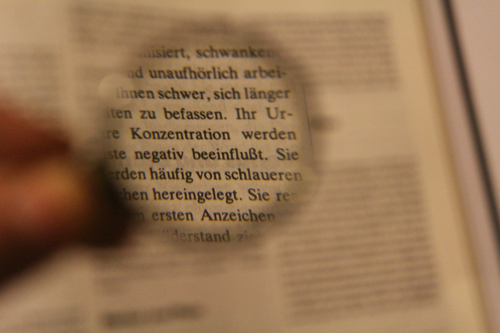LOW VISION CAN AFFECT
BOTH OLD & YOUNG.
Low vision is essentially another term for visual impairment. Low vision can occur at any age but is most common amongst the older generations as our eyes begin to degenerate as we age. Low vision is classified as a ‘significant decrease in visual acuity or a reduction in the field of vision’ which heavily affects and limits the fulfillment of everyday tasks.
Symptoms of Low Vision, loss of central vision – this results in blind spots in the centre of one’s field of vision, causing a range of difficulties in day to day tasks such as reading, writing, interpreting colours, recognizing faces, and completing tasks which require precision.
Reduction in the peripheral vision – also known as ‘tunnel vision’, this limits your field of vision, preventing you from being able to see to the side as though looking through a tunnel (hence the name). As a result, sufferers can have difficulty moving around without frequently bumping into objects.
Blurred vision – objects can appear out of focus and/or hazy at certain distances
Poor night sight – difficulty seeing in darker environments or at night time.
Sensitivity to bright light &glare – difficulty adjusting to/seeing in bright light environments.
Causes of Low Vision: Age-Related Macular Degeneration (AMD) Macular Degeneration affects the central part of the retina called the macula. While leaving the peripheral or lateral vision intact, the loss of central vision heavily affects one’s ability to read, write and recognize details (such as faces). The exact cause of AMD is only partially understood and the condition is most associated with age, however, there is a higher risk developing AMD if it is a hereditary condition or if you are a smoker.
Retinitis Pigmentosa (RP)
Early signs of this condition is a progressive reduction in peripheral vision as well as having difficulties with night vision. Later symptoms can affect reading, colour vision and central vision, which results in low vision. RP is the result of the presence of one or two ‘faulty genes’ and can be inherited.

Cataracts
Cataracts is where a cloudy or blue patch forms on the lens of the eye. Vision becomes increasingly blurred or misty/cloudy, it can become difficult to see at night, and you can develop a sensitivity to bright light. Sight can also take on a yellow or brown tinge, as well as possibly developing double vision or a halo effect. Good eye care can help prevent the onset of cataracts, however there are a few risk factors to keep in mind: smoking, over-exposure to UV rays, regularly drinking excessive amounts of alcohol, diabetes, family history of cataracts, and corticosteroid medication.
Glaucoma
Glaucoma can alter your field of vision, most commonly peripheral and lateral vision. Glaucoma is the build-up of pressure in the eye that can damage the optic nerve. A regular eye examination can help diagnose Glaucoma as quite often there are no early symptoms.
Diabetic Retinopathy
Affecting sufferers of diabetes, this degenerative eye disease occurs when high blood sugar levels damage the cells at the back of the eye, preventing the blood vessels from supplying the retina with nutrients and oxygen. Often, symptoms present when vision has already been affected, which can be permanent by this stage, so it’s important to regularly monitor sugar levels and go for regular diabetic eye screenings.
Vision Aids
Unfortunately, there are not many aids to help with general mobility, such as detecting obstacles or improving distance/depth perception. However, there are a few aids that help reading or near vision tasks:
Magnifying/filtering lenses – these allow for hands free visual aid so wearers can carry out everyday tasks.
Special Lighting – this can help to increase contrast to provide a better understanding/vision of the environment.
Enlargers or magnifiers – There are a range of magnifiers – handheld, illuminated stand, flat-form, pocket, and electronic (allows you to project onto TV screen or monitor as well as adjust contrast, enhance or reverse colours).
Low Vision is often associated with a hereditary condition or simply aging. However, it can affect anyone and it’s good to be aware eye diseases and symptoms so you know when to seek help from an eye care professional, whether for yourself or a loved one.

